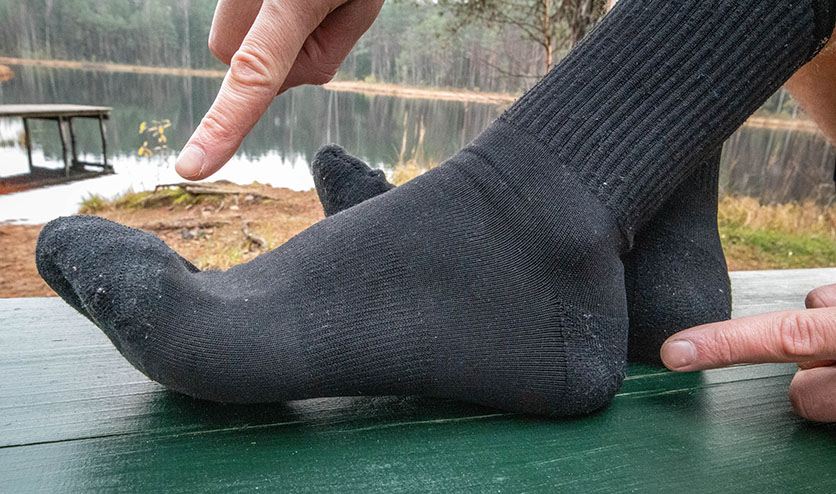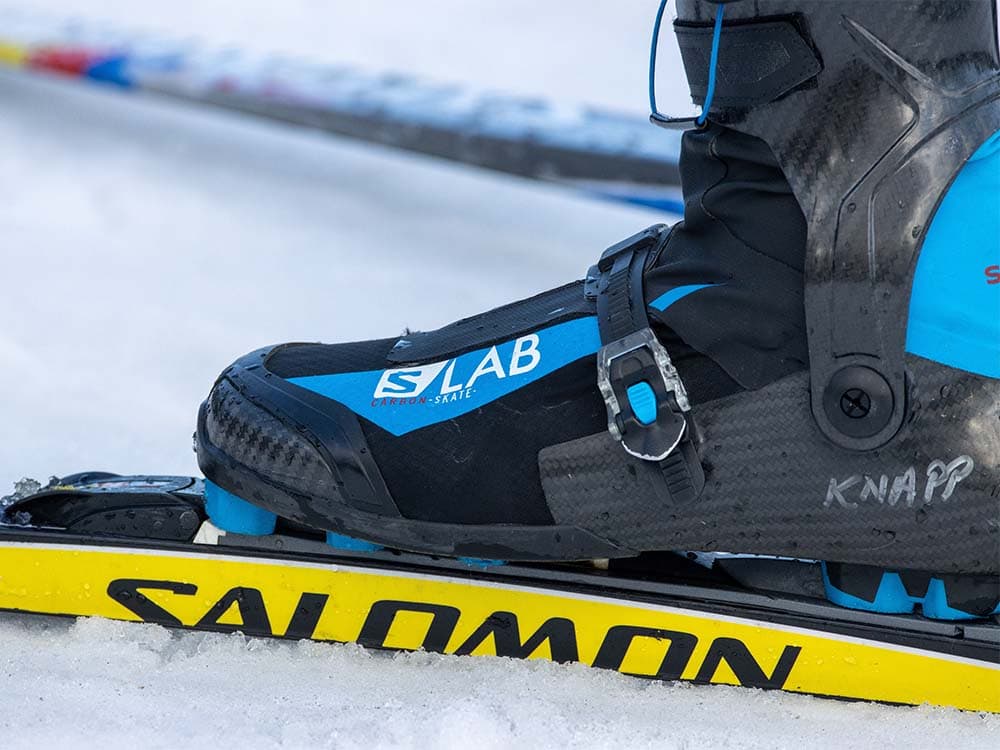Similar to hiking socks, skiing socks are also meant to be used for winter outdoor activities. So naturally, you might think that skiing socks should also be good for winter hiking. However, there are subtle differences.
While some skiing socks will actually work pretty well when hiking in winter, others won’t. Down below, I’ll explain the main differences between skiing and hiking socks, and explain which ones can be used for hiking.
Differences Between Ski Vs Hiking Socks
Ski and hiking socks are usually made from the same materials – merino wool, nylon or polyester, and elastane. Merino wool has good thermoregulation, insulation, and breathability properties, and the added synthetics give it durability, water resistance, and elasticity. So in terms of materials, they’re pretty much identical.
However, ski socks are usually made a bit thinner than hiking socks. That’s because ski and snowboarding boots are much thicker than hiking boots, so there isn’t much need for more insulation. That means that if you’d want to hike in them in very cold temperatures, you’d need to wear two pairs of socks or get hiking boots with a lot of insulation (over 400-600g).
Hiking socks also have padding in different places – usually on the heel, the toebox, and sometimes on the ball and top part of your foot. Ski socks sometimes also have padding around the shin, high-heel (achilles tendon), and ankle areas, which can cause a weird fit or even excessive rubbing in some areas. So if you plan on hiking with skiing socks, test how they fit with your hiking boots first and if there aren’t any tight areas.
And lastly, ski socks are longer than hiking boots, which isn’t necessarily a bad thing, especially in winter. There are a few knee-high hiking socks as well, but not as many as knee-high skiing socks.
Ski Socks Are Better Than Regular Socks For Hiking But Not As Good As Hiking Socks
Ski socks with very little padding (pretty much only around the heel, toebox, and the ball section of your feet) can be a rather good alternative to hiking socks when hiking in autumn, spring, or in warm winters. They’re made from identical materials and are structurally very similar to most crew and knee-high hiking socks, with only minor differences.
However, you can’t use ski socks for really cold temperatures, unless you get a sock liner. Ski socks with medium or heavy cushioning will be thick enough for colder weather, but they will also come with shin and Achilles padding, which will probably cause some bruising on your legs.
What Kind Of Socks Are Good For Hiking

In general, a lot of socks can be used for hiking, including socks made for hunting, running, snowboarding and skiing, mountaineering, outdoor work, and cycling. Some casual socks will also be good for hiking if they’re made from the right materials and have the right properties.
In general, any socks that have these properties can be used for hiking:
- Made from merino wool and synthetics. The most important feature of any hiking sock is its material. Ideally, it should be made from 30-70% merino wool, 30-70% nylon or polyester, and 1-5% elastane, spandex, or Lycra. This blend will achieve good breathability, blister resistance, insulation, odor resistance, durability, and water resistance, which all are important for outdoor activities.
- A snug fit with a bit of compression. Hiking socks shouldn’t feel too tight, otherwise, they might result in blisters or decreased circulation. But they shouldn’t move around your feet either, which can cause them to slip down or result in blisters. In general, good hiking socks should have a bit of compression built into them with added compression panels.
- Padding around the toebox and the heel. These two areas are where you’re most likely to get blisters, so having extra padding there is very helpful.
- Longer than your hiking boots or shoes. Your hiking socks should always be longer than your hiking footwear. Otherwise, they can bruise your legs or feet over time.
Read Next: What Socks To Wear With Hiking Boots
Frequently Asked Questions
Can I use hiking socks for skiing?
Hiking socks are usually made from merino wool and synthetics, which allows for good breathability, insulation, and comfort. This means that they can also be used for skiing, but they aren’t ideal.
The main issue with hiking socks is that they’re generally shorter than skiing boots, which could cause some bruising around the top of the boot. Another problem with hiking socks is that they don’t have any padding around the shin area, which is where most skiers usually suffer from bruising and shock-related injuries.
Read Next: Can You Go Hiking in Cowboy Boots?
Are ski socks thick or thin?
Although most skiers prefer thinner skiing socks, not all skiing socks are thin. Skiing socks are split into different categories based on how much padding they have – no cushioning, light, medium, and heavy cushioning. A sock that has more cushioning will also usually mean that the fabric itself is a bit thicker. For extra-cold weather, you should generally choose medium or heavy cushioning socks.
For hiking, usually only “no cushioning” and “light cushioning” socks are useable because they don’t have any padding around the shin area.
Do ski socks also work as compression socks?
Only a few ski socks have enough compression to work as compression socks. They’re usually used only by top-performing athletes, which require tightly-fitting boots.
That said, most skiing socks do offer a bit of compression, at least when compared to regular socks. That’s because skiing socks need to fit snugly on your feet to not move next to the skin and cause blisters.
Are expensive hiking socks worth it?
From my own experience, it’s worth it to spend more on a good pair of hiking socks. I used to hike with cheap merino wool socks. And although they were better than regular socks, I still got some blisters. That changed when I switched to hiking socks made by a good brand. For context, I thru-hiked 500 miles (800 km) with my Silverlight hiking socks, and I didn’t get a single blister. Plus, I’m still using them today, as I’m writing this article.
Spending 20-40$ for something that will significantly improve your hiking experience and that will last a very long time, in my opinion, is a no-brainer. Most hiking socks made by Darn Tough, Smartwool, Farm to Feet, Danish Endurance, Icebreaker, Silverlight, and others will be of good quality.
